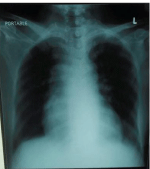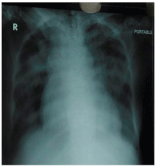Abstract
Transfusion Related Acute Lung Injury (TRALI) is a rare but serious adverse event of allogeneic blood component transfusion, manifested typically by shortness of breath, a non-productive cough, fever, and hypotension, mostly seen after plasma component transfusion collected from female donors. We here present a rare case of TRALI requiring Intensive Care Unit (ICU) support after transfusion of single Packed Red Blood Cell (PRBC) unit collected from a male donor. The present case emphasizes that TRALI to be ruled out first in any patient showing acute /respiratory distress within 6hrs of transfusion, with prompt management and notification to transfusion services.
Keywords: Transfusion related acute lung injury; Packed red blood cell; Blood component transfusion
Background
TRALI is a rare but serious adverse event of blood component transfusion, featured by difficulty in breathing associated with nonproductive cough, elevated body temperature and/or hypotension. It was noticed as early as in 1983 by Popovsky et al., with an incidence of antibody-mediated TRALI, at 1 in 5000 blood component transfusions and non-immune TRALI, at a rate of 1 in 1120 transfusions [1,2].
Case Presentation
We here present a rare case of Transfusion Related Acute Lung Injury (TRALI) requiring Intensive Care Unit (ICU) support after transfusion of single Packed Red Blood Cell (PRBC) unit. Present case was a 68-year-old female, with newly diagnosed Acute Myeloid leukemia with COVID-19 positive and right thigh non-healing Ulcer, having low hemoglobin (7.6g/dl) and low platelet counts (8,000/μl), B positive blood group, admitted for PRBC and platelet transfusions. One unit of B positive PRBC (12 day old, pre-storage leukoreduced and compatible with patient serum at AHG phase in gel card) was released for transfusion from blood bank. Patient was stable prior to transfusion however; she developed difficulty in breathing, lowgrade fever, chills and cyanosis within 2hrs after PRBC transfusion. Saturations of patient were 68% at room air and 94% with 4 liter O2. A blood transfusion adverse event was reckoned with possibilities of TRALI, TACO and sepsis were shortlisted.
Extensive bilateral pulmonary infiltrates were seen in Chest X-ray (CXR) suggesting acute pulmonary micro vascular damage, which leads to both interstitial and alveolar infiltrates. Figure 1a and 1b shows the patient CXR before and after transfusion. The normal readings of central venous pressure and pulmonary capillary wedge pressure exclude the possibility of TACO (4mmHg and 6mmHg respectively).

Figure 1a: Chest X-ray before transfusion.

Figure 1b: Chest X-ray after transfusion.
Inj.Avil, hydrocortisone, furosemide and O2 support managed the patient, but her symptoms did not improve. Hence she was shifted to ICU and required non-invasive ventilator support. On evaluation she had pancytopenia and raised procalcitonin (18.70ng/ml). CXR showed bilateral opacities. The bacterial cultures from the patient and PRBC unit were negative. She responded well to the treatment, patient’s pulmonary edema gradually improved and became asymptomatic in 72hrs with normal CXR and SPO2 94% at room air.
Immunological lab testing on the patient and donor samples for anti-HLA, HNA antibodies were not done due to resource limitations. Details from donor questionnaire revealed blood was collected from a 20-year-old male donor without any significant history of anti-HLA antibody formation. In a study by Sillman et al., only 25% of TRALI cases shown anti HLA antibodies in the donor plasma and there were no antibodies detected in patients/donors in 10-15% cases of TRALI [2].
In the present case, TRALI was suspected because of the rapid onset and significant drop in oxygen levels (pO2 of 65mmHg) with typical features on CXR and non-cardiac pulmonary edema after the RBC transfusion. Also patient does not have any pre-existing Acute Lung Injury (ALI) or any associated risk factor for ALI. A study by Sharma et al., reports similar findings of TRALI in a 10yr old male child after platelet transfusion collected from a young male donor [3].
To prevent antibody-mediated TRALI, it is recommended that transfusions containing anti-leukocyte antibodies should be avoided, e.g., fresh frozen plasma derived only from male donors should be used because of the high anti-leukocyte antibody positivity rate of females with a history of pregnancy, and donors that have previously been associated with TRALI should also be excluded [4,5]. However, this strategy has not completely eradicated the complication. In the past few years, research has identified patient-related risk factors for the onset of TRALI, which have empowered physicians to take an individualized approach to patients who need transfusion [6]. As well as antibodies, plasma proteins and biological response modifiers are also associated with the onset of TRALI. These are contained in plasma; therefore, it has been reported that washed platelet preparations, from which as much plasma as possible is removed, are effective for preventing TRALI [7].
Conclusion
Therefore, the present case emphasizes on prompt management of any patient featuring sudden respiratory difficulty during or in 6 hours of transfusion with suspicion of TRALI as the initial possible cause. And also highlights on timely intimation to transfusion services helping in confirming the diagnosis and identifying at-risk donor and recipients.
References
- Popovsky MA, Moore SB. Diagnostic and pathogenetic considerations in transfusion-related acute lung injury. Transfusion. 1985; 25: 573-577.
- Silliman CC, Boshkov LK, Mehdizadehkashi Z, Elzi DJ, Dickey WO, Podlosky L, et al. Transfusion-related acute lung injury: Epidemiology and a prospective analysis of etiologic factors. Blood. 2003; 101: 454-462.
- Sharma RR, Bhattacharya P, Thakral B, Saluja K, Marwaha N. Transfusion related acute lung injury. Indian J Pathol Microbiol. 2009; 52: 561-563.
- Strong DM, Lipton KS. Transfusion related acute lung injury. Association bulletin 2006-07. Bethesda, MD; American Association of Blood Banks. 2006.
- Eder AF, Herron RM Jr, Strupp A, et al. Effective reduction of transfusionrelated acute lung injury risk with male-predominant plasma strategy in the American Red Cross (2006-2008). Transfusion. 2010; 50: 1732-1742.
- Vlaar, Alexander PJ, and Nicole P Juffermans. “Transfusion-related acute lung injury: a clinical review”. The Lancet. 2013; 382: 984.
- Hirayama F. Current understanding of allergic transfusion reactions: incidence, pathogenesis, laboratory tests, prevention and treatment. British journal of haematology. 2013; 160: 434-444.
